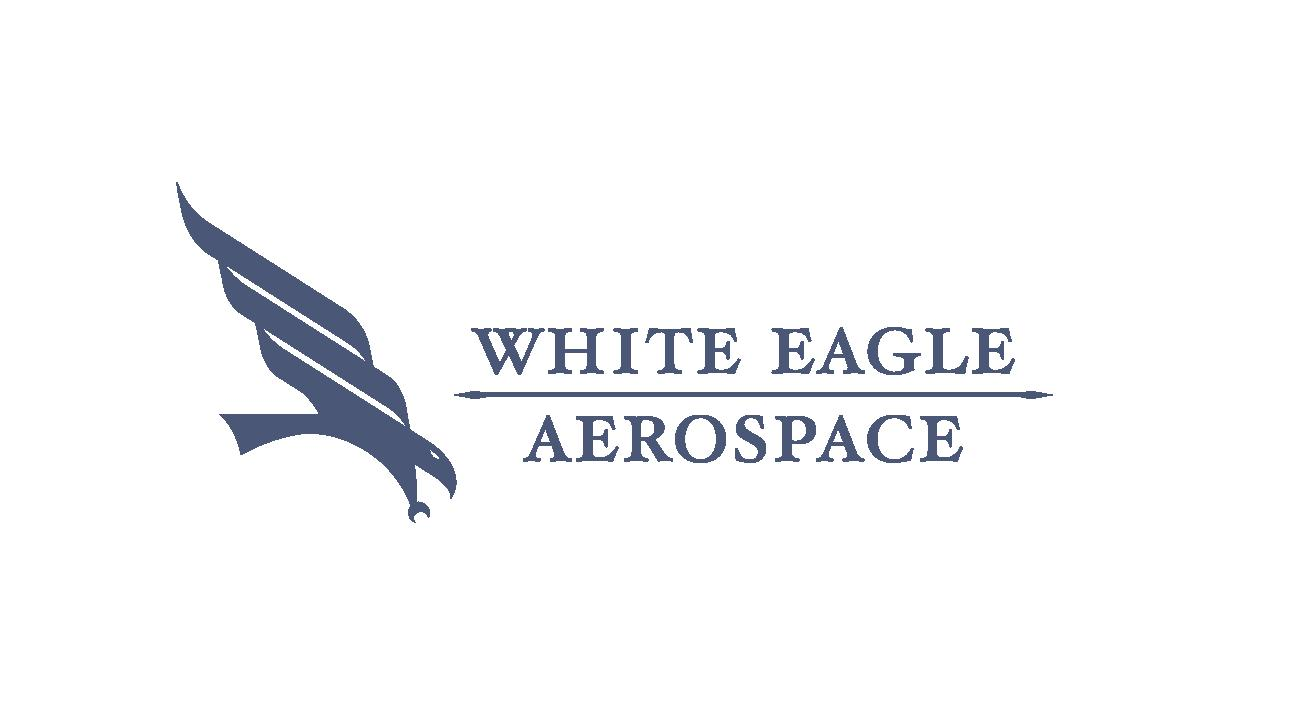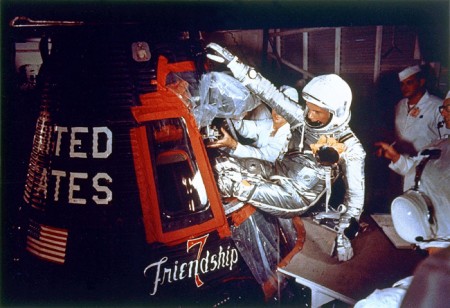
Fifty-one years ago this week, Project Mercury Astronaut John H. Glenn, Jr. became the first American to orbit the Earth. Glenn’s spacecraft name and mission call sign was Friendship 7.
Mercury-Atlas 6 (MA-6) lifted-off from Cape Canaveral’s Launch Complex 14 at 14:47:39 UTC on Tuesday, 20 February 1962. It was the first time that the Atlas LV-3B booster was used for a manned spaceflight.
Three-hundred and twenty seconds after lift-off, Friendship 7 achieved an elliptical orbit measuring 143 nm (apogee) by 86 nm (perigee). Orbital inclination and period were 32.5 degrees and 88.5 minutes, respectively.
The most compelling moments in the United States’ first manned orbital mission centered around a sensor indication that Glenn’s heat shield and landing bag had become loose at the beginning of his second orbit. If true, Glenn would be incinerated during entry.
Concern for Glenn’s welfare persisted for the remainder of the flight and a decision was made to retain his retro package following completion of the retro-fire sequence. It was hoped that the 3 straps holding the retro package would also hold the heat shield in place.
During Glenn’s return to the atmosphere, both the spent retro package and its restraining straps melted in the searing heat of re-entry. Glenn saw chunks of flaming debris passing by his spacecraft window. At one point he radioed, “That’s a real fireball outside”.
Happily, the spacecraft’s heat shield held during entry and the landing bag deployed nominally. There had never really been a problem. The sensor indication was found to be false.
Friendship 7 splashed-down in the Atlantic Ocean at a point 432 nm east of Cape Canaveral at 19:43:02 UTC. John Glenn had orbited the Earth three (3) times during a mission which lasted 4 hours, 55 minutes and 23 seconds. Within short order, spacecraft and astronaut were successfully recovered aboard the USS Noa.
John Glenn became a national hero in the aftermath of his 3-orbit mission aboard Friendship 7. It seemed that just about every newspaper page in the days following his flight carried some sort of story about his historic fete. Indeed, it is difficult for those not around back in 1962 to fully comprehend the immensity of Glenn’s flight in terms of what it meant to the United States and indeed the free world.
John Herschel Glenn, Jr. will turn 92 on 18 July 2013. His trusty steed, the Friendship 7 spacecraft, is currently on display at the Smithsonian National Air and Space Museum in Washington, DC.
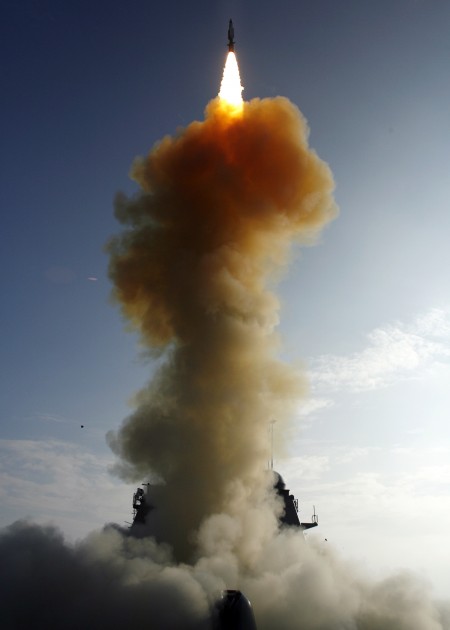
Five years ago this month, a United States Navy STANDARD Missile SM-3 Block IA intercepted and destroyed a failed NRO satellite at an altitude of 133 nautical miles. The relative velocity at intercept was in excess of 22,000 mph.
The United States Navy/Raytheon Missile Systems SM-3 (RIM-161) is the sea-based arm of the Missile Defense Agency’s Ballistic Missile Defense System (BMDS). The 3-stage missile carries a Kinetic Warhead (KW) that provides an exoatmospheric hit-to-kill capability.
In order to ensure a lethal hit, the SM-3 KW guides to a specific aimpoint on the target’s airframe. The ability to reliably do so has been impressively demonstrated in a series of intercept flight tests that began in 2002.
SM-3 rounds are launched from the MK-41 Vertical Launcher System (VLS) aboard United States Navy cruisers and destroyers. The at-sea basing concept provides for a high degree of operational flexibility in the ballistic missile intercept mission.
The Lockheed Martin-built USA-193 was launched on a classified mission from California’s Vandenberg Air Force Base (VAFB) at 2100 UTC on Thursday, 14 December 2006. Shortly after reaching orbit, contact with the 5,000-lb satellite was lost.
By January 2008, USA-193’s orbit had decayed to such an extent that its reentry appeared imminent. Such events raise concerns for the safety of those on Earth who reside within the debris impact footprint. However, there was an additional concern in the case of USA-193. The satellite still had about 1,000-lbs of hydrazine onboard.
Should the USA-193 hydrazine tank survive reentry, those living in the impact area would be exposed to a highly toxic cloud of the volatile substance. Officials concluded that the safest thing to do was to destroy the satellite before it reentered the atmosphere.
On Thursday, 21 February 2008, the USS Lake Erie was on station in the Pacific Ocean west of Hawaii. The US Navy cruiser fired a single SM-3 interceptor at 0326 UTC. Minutes later, the missile’s KW took out the satellite and dispersed its hydrazine load into space. Mission accomplished!
In the aftermath of the satellite take-down, Russia and others predictably accused the United States of using the USA-193 hydrazine issue as an excuse to demonstrate SM-3’s anti-satellite capability. While such capability was indeed demonstrated, noteworthy is the fact that all systems modified to execute the satellite intercept were subsequently returned to a ballistic missile defense posture.
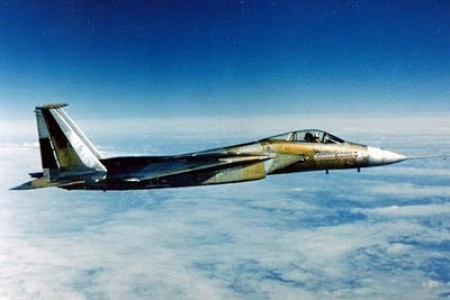
Thirty-eight years ago this month, an USAF F-15A Eagle reached an altitude of 30 km (98,425 feet) 207.8 seconds from brake release. The pilot for the record-breaking mission was USAF Major Roger Smith.
Operation Streak Eagle was a mid-1970’s effort by the United States Air Force to set eight (8) separate time-to-climb records using the McDonnell-Douglas F-15 Air Superiority Fighter. These record-setting flights originated from Grand Forks Air Force Base in North Dakota.
Starting on Thursday, 16 January 1975, the 19th pre-production F-15 Eagle aircraft (S/N 72-0119) was used to establish the following time-to-climb records during Operation Streak Eagle:
3 km, 16 January 1975, 27.57 seconds, Major Roger Smith
6 km, 16 January 1975, 39.33 seconds, Major Willard Macfarlane
9 km, 16 January 1975, 48.86 seconds, Major Willard Macfarlane
12 km, 16 January 1975, 59.38 seconds, Major Willard Macfarlane
15 km, 16 January 1975, 77.02 seconds, Major David Peterson
20 km, 19 January 1975, 122.94 seconds, Major Roger Smith
25 km, 26 January 1975, 161.02 seconds, Major David Peterson
The eighth and final time-to-climb record attempt of Operation Streak Eagle took place on Saturday, 01 February 1975. The goal was to set a new time-to-climb record to 30 km. The pilot was required to wear a full pressure suit for this mission.
At a gross take-off weight of 31,908 pounds, the Streak Eagle aircraft had a thrust-to-weight ratio in excess of 1.4. The aircraft was restrained via a hold-down device as the two Pratt and Whitney F100 turbofan engines were spooled-up to full afterburner.
Following hold-down and brake release, the Streak Eagle quickly accelerated during a low level transition following take-off. At Mach 0.65, Smith pulled the aircraft into a 2.5-g Immelman. The Streak Eagle completed this maneuver 56 seconds from brake release at Mach 1.1 and 9.75 km. Rolling the aircraft upright, Smith continued to accelerate the Streak Eagle in a shallow climb.
At an elapsed time of 151 seconds and with the aircraft at Mach 2.2 and 11.3 km, Smith executed a 4-g pull to a 60-degree zoom climb. The Steak Eagle passed through 30 km at Mach 0.7 in an elapsed time of 207.8 seconds. The apex of the zoom trajectory was about 31.4 km. With a new record in hand, Smith uneventfully recovered the aircraft to Grand Forks AFB.
Operation Streak Eagle ended with the capturing of the 30 km time-to-climb record. In December 1980, the aircraft was retired to the USAF Museum at Wright-Patterson Air Force Base in Dayton, Ohio. It is currently held in storage at the Museum and no longer on public display.
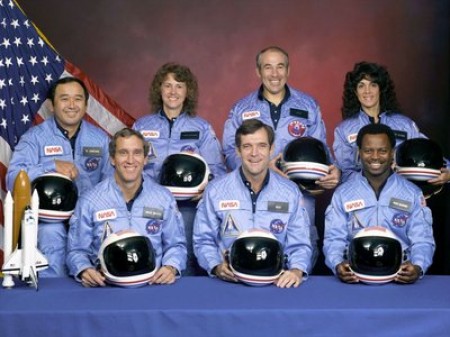
Twenty-seven years ago today, the seven member crew of STS-51L were killed when the Space Shuttle Challenger disintegrated 73 seconds after launch from LC-39B at Cape Canaveral, Florida. It was the first fatal in-flight accident in American spaceflight history.
In remarks made at a memorial service held for the Challenger Seven in Houston, Texas on Friday, 31 January 1986, President Ronald Wilson Reagan expressed the following sentiments:
“The future is not free: the story of all human progress is one of a struggle against all odds. We learned again that this America, which Abraham Lincoln called the last, best hope of man on Earth, was built on heroism and noble sacrifice. It was built by men and women like our seven star voyagers, who answered a call beyond duty, who gave more than was expected or required and who gave it little thought of worldly reward.”
We take this opportunity now to remember the heroic fallen:
Francis R. (Dick) Scobee, Commander
Michael John Smith, Pilot
Ellison S. Onizuka, Mission Specialist One
Judith Arlene Resnik, Mission Specialist Two
Ronald Erwin McNair, Mission Specialist Three
S.Christa McAuliffe, Payload Specialist One
Gregory Bruce Jarvis, Payload Specialist Two
Speaking for his grieving countrymen, President Reagan closed his eulogy with these words:
“Dick, Mike, Judy, El, Ron, Greg and Christa – your families and your country mourn your passing. We bid you goodbye. We will never forget you. For those who knew you well and loved you, the pain will be deep and enduring. A nation, too, will long feel the loss of her seven sons and daughters, her seven good friends. We can find consolation only in faith, for we know in our hearts that you who flew so high and so proud now make your home beyond the stars, safe in God’s promise of eternal life.”
Tuesday, 28 January 1986. We Remember.

Four years ago this month, US Airways Flight 1549 successfully ditched in the Hudson River following loss of thrust in both turbofan engines. Incredibly, all 155 passengers and crew members survived.
US Airways Flight 1549 lifted-off from Runway 4 of New York’s LaGuardia Airport at 18:25:56 UTC on Thursday, 15 January 2009. The Airbus 320-214 (N106US) was making its 16,299th flight. Call sign for the day’s flight was Cactus 1549.
Captain Chesley B. Sullenberger III and First Officer Jeffrey B. Skiles were in the cockpit of Cactus 1549. Donna Dent, Doreen Welsh and Sheila Dail served as flight attendants. Together, these crew members were responsible for the lives of 150 airline passengers.
Following a normal take-off, Cactus 1549 collided with a massive flock of Canadian Geese climbing through 3,000 feet. Numerous bird strikes were experienced. Most critically, both CFM56-5B4/P turbofan engines suffered bird ingestion. As Captain Sullenberger succinctly described it later, the result was “sudden, complete, symmetrical” loss of thrust.
Quickly assessing their predicament, Captain Sullenberger instinctively knew that he could not get his aircraft back to a land-based runway. He was flying too low and slow to make such an attempt. He would have to ditch his 150,000-pound aircraft in the nearest waterway; the Hudson River.
The story of what ensued following loss of thrust is best told by Captain Sullenberger himself. The reader is therefore directed to chapters 13 and 14 of his post-mishap book entitled “Highest Duty”. The bottom line is that the aircraft was successfully ditched in the Hudson River roughly three and half minutes after loss of thrust.
Once the aircraft was on the water, the crew members evacuated all 150 passengers in less than 4 minutes. People either got into life rafts or stood on the aircraft’s wings. It was very cold. Air temperature was 21F with a windchill factor of 11F. The water temperature registered at 36F.
First responders from the New York Waterway quickly came to the aid of Cactus 1549. A total of fourteen vessels responded to the emergency with the first boat arriving within four minutes of the aircraft coming to a stop.
Many selfless acts of compassion and exemplary displays of valor were observed during Cactus 1549 rescue operations. This was true for those amongst the ranks of the rescuers and rescued alike.
Happily and to the great relief of the US Airways flight crew, there was no loss of life resulting from the emergency ditching of Cactus 1549. Now known as “The Miracle on the Hudson”, the events of that harrowing experience on a winter day in NYC will be forever remembered in the annals of aviation.
For their professional efforts in handling the Cactus 1549 in-flight emergency, Chesley Sullenberger, Jeff Skiles, Donna Dent, Doreen Welsh and Sheila Dail received the rarely-awarded Guild of Air Pilots and Air Navigators Master’s Medal on Thursday, 22 January 2009.
In part, the Master’s Medal citation read: “The reactions of all members of the crew, the split second decision making and the handling of this emergency and evacuation was ‘text book’ and an example to us all. To have safely executed this emergency ditching and evacuation, with the loss of no lives, is a heroic and unique aviation achievement.”
To which we say: Amen!
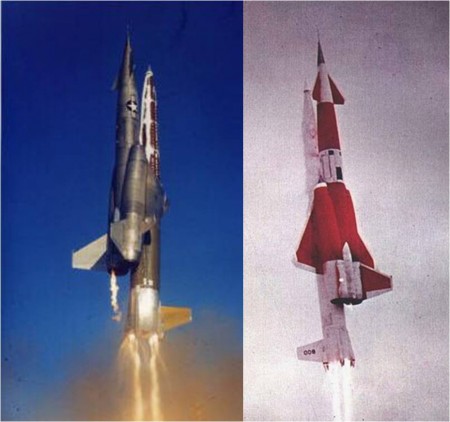
Fifty-five years ago this month, a XSM-64 Navaho G-26 flight test vehicle flew 1,075 miles in 40 minutes at a sustained speed of Mach 2.8. It was the 8th flight test of the ill-fated Navaho Program.
The post-World War II era saw the development of a myriad of missile weapons systems. Perhaps the most influential and enigmatic of these systems was the Navaho missile.
Navaho was intended as a supersonic, nuclear-capable, strategic weapon system. It consisted of two (2) stages. The first stage was rocket-powered while the second stage utilized ramjet propulsion. The aircraft-like second stage was configured with a high lift-to-drag airframe in order to achieve strategic reach.
While there were a number of antecedants dating back to 1946, the Navaho Program really began in 1950 as Weapon System 104A. The requirements included a range of 5,500 miles, a minimum cruise speed of Mach 3 and a minimum cruise altitude of 60,000 feet. The payload included an ordnance load of 7,000 pounds delivered within a CEP of 1,500 feet.
North American Aviation (NAA) proposed a 3-phase development plan for WS-104A. Phase 1 involved testing of the missile alone (the X-10) up to Mach 2. Phase 2 covered the testing of the two-stage launch vehicle (the G-26) up to Mach 2.75 and a range of 1,500 miles. Phase 3 would be the ultimate near-production vehicle (the G-38). Only Phase 1 and Phase 2 testing took place.
The Navaho missile-booster vehicle measured 84 feet in length and weighed about 135,000 pounds at lift-off. The launch weight for the booster was 75,000 pounds; most of which was due to the alcohol and LOX propellants. The missile empty weight was 24,000 pounds.
On Friday, 10 January 1958, Navaho G-26 No. 9 (54-3098) lifted-off from LC-9 at Cape Canaveral, Florida. Climbing out under 240,000 pounds of thrust from its dual Rocketdyne XLR71-NA-1 rocket motors, missile-booster separation occurred at Mach 3.15 and 73,000 feet. Following air-start and take-over of twin Wright XRJ47-W-5 ramjets, generating a combined thrust of 16,000 pounds, the Navaho missile initiated a near triple-sonic cruise toward the Puerto Rico target area.
As the Navaho missile approached the environs of Puerto Rico, the vehicle was commanded to initiate a sweeping right-hand turn back towards the Cape. Unfortunately, the right intake experienced an unstart and a concommitant, asymmetric loss of thrust. Underpowered and without a restart capability, the vehicle was subsequently commanded to execute a dive into the Atlantic.
Flight No. 8, although only partially successful, flew longer and farther than any Navaho flight test vehicle. Only G-26 Flight No. 6 flew faster (Mach 3.5).
Although three (3) flights would follow G-26 Flight No. 8, all would suffer failure of one kind or another. In point of fact, the Navaho Program had been canceled on Saturday, 13 July 1957. The final six (6) Navaho flights were simply an attempt to extract the most from the remaining missile-booster rounds. Over 15,000 NAA employees lost their jobs the day Navaho died.
Navaho was cancelled primarily due to the ascendancy of the Intercontinental Ballistic Missile (ICBM). Very simply, an ICBM could deliver nuclear ordnance farther, faster and more accurately than a winged, unstealthy strategic missile. Navaho’s relatively numerous technical issues and programmatic delays simply served to drive the final nail into a long-prepared coffin.
While few today remember or even know of the Navaho Program, its technology has had a profound influence on all manner of aerospace vehicles up to the present day. Interestingly, the Space Shuttle launch vehicle concept bears a strong resemblance to the Navaho missile-booster combination. That is, a winged flight vehicle mounted asymmetrically on a longer boost vehicle.
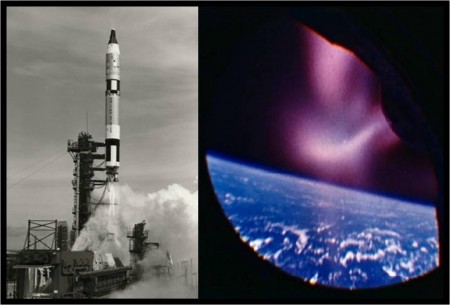
Forty-eight years ago this month, NASA successfully completed the unmanned Gemini-Titan 2 (GT-2) space mission. The suborbital spaceflight served as a final test preparatory to the first manned Gemini mission (GT-3) flown several months later.
The Gemini Program was America’s second manned space project. Gemini pioneered key technologies required to land men on the Moon including space navigation, rendezvous, docking, orbital maneuvering, long-duration spaceflight and extra-vehicular activity (EVA). Without Gemini, the United States would not have achieved the goal of landing men on the Moon before the end of the 1960’s.
The two-man Gemini spacecraft weighed 8,500 pounds at lift-off and measured 18.6 feet in length. Gemini consisted of a reentry module (RM), an adapter module (AM) and an equipment module (EM).
The crew occupied the RM which also contained ships’ navigation, communication, telemetry, electrical and reentry reaction control systems. The AM contained maneuver thrusters and the deboost rocket system. The EM included the spacecraft orbital attitude control thrusters and the fuel cell system. Both the AM and EM were used in orbit only and discarded prior to entry.
A two-stage Titan II launch vehicle served as the chariot that Gemini rode into space. Designed for the Intercontinental Ballistic Missile (ICBM) role, the native reliability of the Titan II had to be substantially improved for the vehicle to safely carry men into space. The history of spaceflight records that the man-rated Titan II truly fulfilled the measure of its creation by successfully launching ten (10) Gemini crews into earth orbit.
Gemini-Titan (GT-2) was the second and last unmanned flight test of the Gemini spacecraft. Since the primary goal was to flight-prove the craft’s heat shield performance during reentry, the mission was suborbital in nature. GT-2 lifted-off from Cape Canaveral’s LC-19 at 14:22:14 UTC on Tuesday, 19 January 1965. The vehicle’s arcing ballistic trajectory took it over the Atlantic Ocean on a flight that lasted only 18 minutes and 16 seconds. Maximum altitude and impact range were 92.4 nm and 1,847.5 nm, respectively.
Gemini 2’s ablative heat shield functioned as designed and came through the fiery reentry in excellent condition. Most of the spacecraft’s other flight systems performed satisfactorily during the vehicle’s brief sojourn into the heavens. Exceptions here included the fuel cell system which failed prior to lift-off and cooling system temperatures which exceeded design requirements.
Gemini 2’s splashdown point was located approximately 45 nm from the USS Lake Champlain. About 90 minutes after splashdown, Gemini 2 was hauled aboard the recovery ship. The spacecraft came through the flight in such good shape that it actually flew a second suborbital reentry in November of 1966. Along with the OPS 0855 boilerplate spacecraft, the Gemini 2 reentry module was flown aboard a Titan IIIC launch vehicle in support of the USAF Manned Orbiting Laboratory (MOL) Program.
The successful completion of GT-2 (along with the previous GT-1 orbital mission) provided NASA with the confidence needed to proceed with manned Gemini missions. The first of ten (10) such missions, GT-3, was successfully flown in March of 1965. A mere 20 months later (December 1966), the Gemini Program was brought to a successful conclusion with the splashdown of Gemini 12.
The Gemini Program was remarkable for its many significant and historic spaceflight achievements that paved the way to the moon. The brief mission of Gemini-Titan 2 was a small, but important part of that larger story. Today, aerospace aficionados can view the twice-flown Gemini 2 reentry module at the Air Force Space and Missile Museum, Cape Canaveral, Florida.
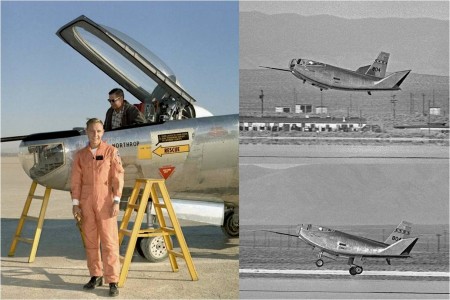
Forty-six years ago this month, the Northrop HL-10 lifting body made its first unpowered free flight. Following drop from NASA’s venerable NB-52B launch aircraft, test pilot Bruce A. Peterson successfully landed the HL-10 on Rogers Dry Lake at Edwards Air Force Base, California.
A lifting body is a wingless, aircraft-like vehicle which generates aerodynamic lift via the shape and size of its fuselage. The principal application for such a craft is in the realm of hypersonic lifting entry. The attributes of greatest interest here include the type’s favorable lift-to-drag characteristics and effective handling of the entry aerodynamic heating environment.
A true lifting body must operate at Mach numbers that range from hypersonic to subsonic. Flight controls are both aerodynamic and propulsive in nature. The former includes body flaps for pitch and roll control as well as rudders for yaw control. Propulsive thrusters are strategically arranged on the vehicle to augment control about all 3-axes at high altitude where dynamic pressure is low to negligible.
A lifting body’s unconventional shape makes the stability and control design task particularly challenging. The craft must fly at high angles-of-attack and large bank angles during hypersonic flight for trajectory ranging and aero heating accommodation purposes. Lifting bodies can also exhibit nasty lateral-directional handling qualities in the low-speed regime associated with landing.
Lifting bodies first came onto the aerospace scene in the 1960’s. An unmanned vehicle known as PRIME (Precision Recovery Including Maneuvering Entry) successfully flew a trio of suborbital flight tests between December 1966 and April 1967. High speed vehicle flight control was found to be entirely satisfactory.
A total of six (6) manned lifting body vehicles were tested at Edwards Air Force Base between 1963 and 1975. The subject aircraft included the NASA M2-F1, Northrop M2-F2, Northrop M2-F3, Martin X-24A, Martin X-24B and the Northrop HL-10. The primary purpose of this family of research vehicles was to investigate the transonic and subsonic flight characteristics of piloted lifting body aircraft.
The Northrop HL-10 measured 22.17 feet in length, 11.5 feet in height and 15.58 feet in width. The vehicle was configured with an XLR-11 rocket motor capable of generating 6,000 lbs of sea level thrust. GTOW for the single place vehicle was 9,000 lbs. NASA’s lengendary NB-52B mothership served as the launch aircraft. Drop typically took place at 450 mph and 45,000 feet.
The one and only HL-10 lifting body (S/N 804) made its inaugural free flight on Friday, 22 December 1967. NASA test pilot Bruce A. Peterson was at the controls of the tubby little ship. Since this flight was unpowered, the HL-10 was on the ground just 187 seconds after drop. The HL-10 handled well during the brief test flight and Peterson greased the landing.
The HL-10 flight test program was highly productive. Much was learned in the way of lifting body vehicle stability, control, and handling qualities. The HL-10 holds the distinction of flying higher (90,279 feet) and faster (1,227.5 mph; Mach 1.86) than any lifting body in aviation history.
The HL-10 completed a total of 37 missions (26 powered), the last of which occurred on Friday, 17 July 1970. In addition to Bruce Peterson (who, interestingly, flew only the first flight test), the aircraft was flown by John A. Manke (10 flights), William H. Dana (9 flights), Jerauld R. Gentry (9 flights) and Peter C. Hoag (8 flights).
Happily, the HL-10 airframe survived its flight test program intact. In tribute to its many aeronautical contributions, the aircraft has been preserved for posterity at Edwards Air Force Base. It is currently on public display, mounted on a pole, just outside the gate of the NASA Dryden Flight Research Center (DFRC).
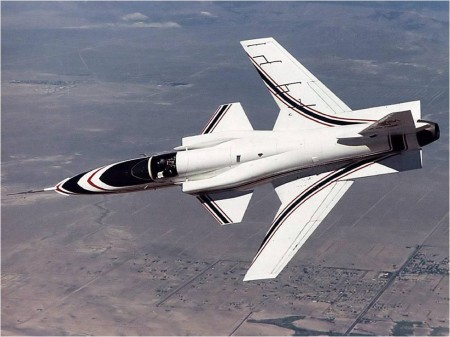
Twenty-eight years ago this month, the first DARPA/Grumman X-29A Forward Swept Wing experimental aircraft took to the air. The flight originated from Edwards Air Force Base with Grumman Chief Test Pilot Chuck Sewell at the controls.
The X-29A was designed to flight test the forward-swept wing (FSW) concept as applied to a fighter-type aircraft. The theoretical merits of this concept include greater agility, slower stall speeds, higher spin resistance, and better low-speed flight control relative to an aft-swept wing (ASW).
A key attribute of the FSW is that spanwise flow is directed from the wing tip toward the wing root. The result is that the wing root stalls before the wing tip at high angle-of-attack. This is advantageous in that a root stall is a more controllable flow condition than is a tip stall.
Due to the FSW’s inward spanwise flow, the outboard-located ailerons retain full control effectiveness since they remain in high energy air. Additionally, wing tip vortex strength is reduced and the associated drag-to-lift decreased. This results in better fuel economy and increased range performance.
Of course, these and other FSW benefits come at a price. The primary issue is related to wing structural dynamic characteristics. Due to the elastic nature of the wing structure, lift on a FSW tends to bend the wing tips upward. This deflection causes an increase in wing tip lift, which causes further bending. This problem becomes more severe with increasing aircraft speed.
The divergent structural response noted above will eventually cause the wing to structurally fail unless it is built strong enough to resist bending. Prior to the X-29A, the only solution to the FSW aeroelastic problem was to build a structually-strong, but very heavy wing. The X-29A would solve this problem through the medium of high-strength, lightweight composite wing construction.
The X-29A used an aeroelastically-tailored wing to provide the structural strength and stiffness required to effectively and safely employ its FSW. Carbon composite material was utilized to provide this weight-efficient solution to the age-old FSW structural divergence problem. The desired aeroelastic tailoring was achieved through judicious orientation of the constituent layers of carbon fiber.
In addition to aeroelastic tailoring of its wings, the X-29A also incorporated a number of other technologies to optimize its overall performance. These technologies included the use of relaxed static stability, a digital fly-by-wire flight control system, a thin supercritical airfoil section, three-surface pitch control, discrete variable-camber wing flaperons and full-authority close-coupled canards.
A pair of X-29A airframes ( S/N 82-0003 and 82-0004) were built by Grumman. These aircraft were converted from two existing Northrop F-5A Freedom Fighters. Control surface actuators and main landing gear came from the General Dynamics F-16 Fighting Falcon. The X-29A aircraft had a GTOW of 17,800 lbs. Power was supplied by a single General Electric F404 turbofan rated at 16,000 lbs of sea level thrust.
X-29A Ship No. 1 (S/N 82-0003) made its first flight on Friday, 14 December 1984 with Grumman Chief Test Pilot doing the honors. This flight took place at Edwards Air Force Base, California and was entirely satisfactory. Ship No. 1 would go on to make 254 flights before its retirement in 1990. Its stablemate (Ship No. 2, S/N 82-0049) first flew in May of 1989, flew 120 times and was retired in September 1991.
The X-29A Program was highly successful and thoroughly proved the technologies that made the FSW concept viable. Happily, both X-29A aircraft survived the type’s flight test program. Today, Ship No. 1 (S/N 82-0003) can be seen at the USAF National Museum in Dayton, OH. Ship No. 2 (S/N 82-0049) is displayed in front of the Dryden Flight Research Center located at Edwards Air Force Base, California.
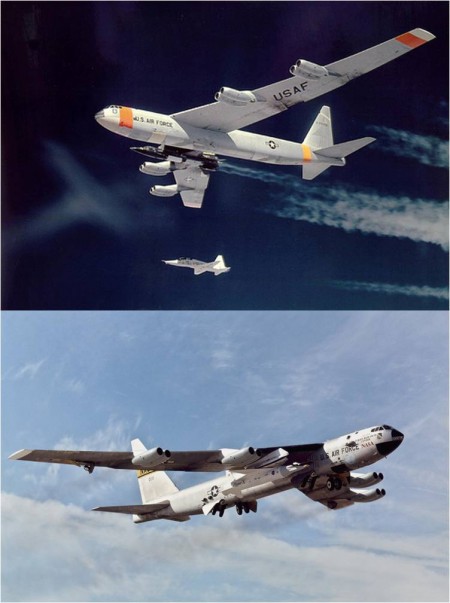
Eight years ago today, NASA’s storied NB-52B Stratofortress launch aircraft was retired following 44 years of service to the American flight research community. Although it was on flying status for nearly 50 years, the aircraft accumulated a total of only 2,443.8 flight hours.
The aircraft that became the NASA NB-52B (S/N 56-0008) started life as an RB-52B when it rolled off of the Boeing assembly line in 1955. First flight occurred on Saturday, 11 June 1955. USAF employed the aircraft as a testbed for B-52 bomb navigation systems.
In June of 1959, the aircraft joined the X-15 Program as a launch aircraft for North American’s famous manned hypersonic flight research rocket plane. Now designated as NB-52B, the eight-engine behemoth had previously been modified for the “mothership” role. The aircraft ultimately acquired the moniker “Balls 8” in deference to the last 4 digits in its USAF serial number.
Based at Edwards Air Force Base in California, the NB-52B made its X-15 Program debut on Saturday, 23 January 1960. On this day, Balls 8 launched X-15 Ship No. 1 (S/N 56-6670) with North American test pilot Scott Crossfield at the controls. It was the fifth flight test of the X-15 Program.
When the X-15 Program ended in late 1969, NASA’s NB-52B had served as the launch aircraft for roughly 140 of the X-15’s 199 research flights. But there would be many more chapters written in the hugh mothership’s story. Indeed, this story would continue to unfold over the next 35 years.
The list of flight test programs supported by Balls 8 is impressive by any measure. Among others, the NB-52B served as the launch aircraft for the legendary lifting body series (M2-F2, M2-F3, HL-10, X-24A and X-24B). Included in this list is the X-38 Crew Return Vehicle (CRV).
NASA’s NB-52B served as the first carrier aircraft for Orbital Science’s Pegasus air-launched, winged, multi-stage rocket. Balls 8 also supported the Space Shuttle Program by dropping solid rocket booster test vehicles to flight test the Shuttle booster’s parachute recovery system. The Space Shuttle Orbiter’s retro-fitted landing drogue parachute was also tested by Balls 8.
The last flight research project supported by NASA’s fabled NB-52B was the HYPER-X Program. This experimental effort involved flight testing an airframe-integrated scramjet engine on an X-aircraft known as the X-43A. Fittingly, Balls 8’s last flight test program would be like its first in that both involved hypersonic flight.
Balls 8 made its last flight on Tuesday, 16 November 2004. The mission was entirely successful as the X-43A scramjet operated at Mach 9.68 (6,598 mph at 110,000 feet). Balls 8 triumphantly returned to Edwards Air Force Base and performed one final flyover of the NASA Dryden Flight Research Center. The aircraft actually made two landings as first the co-pilot and then the command pilot landed on the concrete.
Balls 8 was officially retired on Friday, 17 December 2004 in ceremonies jointly conducted by USAF and NASA. As part of the festivities, NASA returned the NB-52B to the Air Force since technically the aircraft had been on indefinite loan to NASA since the late 1950’s! Today, the aircraft is on public display outside just the north gate at Edwards Air Force Base.











